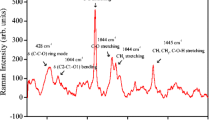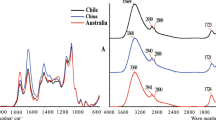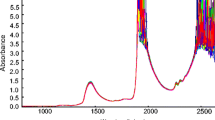Abstract
Shaoxing rice wine (also called Shaoxing wine) is the most well-known Chinese rice wine in China. The common fraudulent practice in the commercialization of Chinese rice wine is to sell wines from different geographical origins under the denomination of Shaoxing rice wine. In this study, the use of near-infrared (NIR) spectroscopy combined with chemometrics as a rapid tool for the discrimination of Chinese rice wine from three geographical origins (“Fujian”, “non-Shaoxing”, “Shaoxing”) has been preliminarily investigated. NIR spectra were collected in transmission mode in the wavelength range of 800–2,500 nm. Discriminant models were developed by principal component analysis (PCA), discriminant analysis (DA), and discriminant partial least-squares analysis (DPLS). The chemical properties of Chinese rice wine were also investigated to find out the difference between samples from three varied origins. The results showed that good classification could be obtained after spectral pre-treatment. The percentage of samples correctly classified by both DA and DPLS methods in calibration and validation set was 97.2% and 100%, respectively. The results demonstrated that NIR could be used as a simple and rapid technique to distinguish Shaoxing wines from non-Shaoxing wines and Fujian wines. To further validate the ability of NIR spectroscopy, more samples should be incorporated to build a more robust model.





Similar content being viewed by others
References
Aleixandre, M., Lozano, J., Gutierrez, J., Sayago, I., Fernandez, M. J., & Horrillo, M. C. (2008). Portable e-nose to classify different kinds of wine. Sensors and Actuators B-Chemical, 131(1), 71–76.
Andre, M. (2003). Multivariate analysis and classification of the chemical quality of 7-aminocephalosporanic acid using near-infrared reflectance spectroscopy. Analytical Chemistry, 75(14), 3460–3467.
Beltran, N. H., Duarte-Mermoud, M. A., Bustos, M. A., Salah, S. A., Loyola, E. A., Pena-Neira, A. I., et al. (2006). Feature extraction and classification of Chilean wines. Journal of Food Engineering, 75(1), 1–10.
Blanco, M., & Villarroya, I. (2002). NIR spectroscopy: a rapid-response analytical tool. Trac-Trends in Analytical Chemistry, 21(4), 240–250.
Chen, Y., Xie, M. Y., Yan, Y., Zhu, S. B., Nie, S. P., Li, C., et al. (2008). Discrimination of Ganoderma lucidum according to geographical origin with near infrared diffuse reflectance spectroscopy and pattern recognition techniques. Analytica Chimica Acta, 618(2), 121–130.
Cozzolino, D., Smyth, H. E., & Gishen, M. (2003). Feasibility study on the use of visible and near-infrared Spectroscopy together with chemometrics to discriminate between commercial white wines of different varietal origins. Journal of Agricultural and Food Chemistry, 51(26), 7703–7708.
Cozzolino, D., Smyth, H. E., Lattey, K. A., Cynkar, W., Janik, L., Dambergs, R. G., et al. (2005). Relationship between sensory analysis and near infrared spectroscopy in Australian Riesling and Chardonnay wines. Analytica Chimica Acta, 539(1–2), 341–348.
Cozzolino, D., Kwiatkowski, M. J., Dambergs, R. G., Cynkar, W. U., Janik, L. J., Skouroumounis, G., et al. (2008). Analysis of elements in wine using near infrared spectroscopy and partial least squares regression. Talanta, 74(4), 711–716.
Dambergs, R. G., Kambouris, A., Francis, I. L., & Gishen, M. (2002). Rapid analysis of methanol in grape-derived distillation products using near-infrared transmission spectroscopy. Journal of Agricultural and Food Chemistry, 50(11), 3079–3084.
Dixon, S. J., & Brereton, R. G. (2009). Comparison of performance of five common classifiers represented as boundary methods: Euclidean distance to centroids, linear discriminant analysis, quadratic discriminant analysis, learning vector quantization and support vector machines, as dependent on data structure. Chemometrics and Intelligent Laboratory Systems, 95(1), 1–17.
Fu, X., Zhou, Y., Ying, Y., Lu, H., & Xu, H. (2007). Discrimination of pear varieties using three classification methods based on near-infrared spectroscopy. Transactions of the Asabe, 50(4), 1355–1361.
Galgano, F., Favati, F., Camso, M., Scarpa, T., & Palma, A. (2008). Analysis of trace elements in southern Italian wines and their classification according to provenance. Lwt-Food Science and Technology, 41(10), 1808–1815.
Garde-Cerdan, T., Lorenzo, C., Alonso, G. L., & Salinas, M. R. (2010). Employment of near infrared spectroscopy to determine oak volatile compounds and ethylphenols in aged red wines. Food Chemistry, 119(2), 823–828.
Kruzlicova, D., Mocak, J., Balla, B., Petka, J., Farkova, M., & Havel, J. (2009). Classification of Slovak white wines using artificial neural networks and discriminant techniques. Food Chemistry, 112(4), 1046–1052.
Lafargue, M. E., Feinberg, M., Daudin, J. J., & Rutledge, D. N. (2003). Detection of heterogeneous wheat samples using near infrared spectroscopy. Journal of Near Infrared Spectroscopy, 11(2), 109–121.
Lanza, E., & Li, B. W. (1984). Application for near-infrared spectroscopy for predicting the sugar content of fruit juices. Journal of Food Science, 49(4), 995–998.
Lin, P., Chen, Y. M., & He, Y. (2009). Identification of geographical origin of olive oil using visible and near-infrared spectroscopy technique combined with chemometrics. Food and Bioprocess Technology. doi:10.1007/s11947-009-0302-z.
Lister, S. J., Dhanoa, M. S., Stewart, J. L., & Gill, M. (2000). Classification and comparison of Gliricidia provenances using near infrared reflectance spectroscopy. Animal Feed Science and Technology, 86(3–4), 221–238.
Liu, F., & He, Y. (2009). Discrimination of producing areas of Auricularia auricular using visable/near infrared spectroscopy. Food and Bioprocess Technology.. doi:10.1007/s11947-00800174-7.
Liu, L., Cozzolino, D., Cynkar, W. U., Gishen, M., & Colby, C. B. (2006). Geographic classification of Spanish and Australian tempranillo red wines by visible and near-infrared spectroscopy combined with multivariate analysis. Journal of Agricultural and Food Chemistry, 54(18), 6754–6759.
Liu, L., Cozzolino, D., Cynkar, W. U., Dambergs, R. G., Janik, L., O'Neill, B. K., et al. (2008). Preliminary study on the application of visible-near infrared spectroscopy and chemometrics to classify Riesling wines from different countries. Food Chemistry, 106(2), 781–786.
Mao, L. C., Xu, Y., & Fan, W. L. (2010). Characterization of aroma compounds in Chinese rice wine Qu by solvent-assisted flavor evaporation and headspace solid-phase microextraction. Journal of Agricultural and Food Chemistry, 58(4), 2462–2469.
Niu, X. Y., Yu, H. Y., & Ying, Y. B. (2008). The Application of near-Infrared Spectroscopy and chemometrics to classify shaoxing wines from different breweries. Transactions of the Asabe, 51(4), 1371–1376.
Park, B., Abbott, J. A., Lee, K. J., Choi, C. H., & Choi, K. H. (2003). Near-infrared diffuse reflectance for quantitative and qualitative measurement of soluble solids and firmness of delicious and Gala apples. Transactions of the Asae, 46(6), 1721–1731.
Pontes, M. J. C., Santos, S. R. B., Araujo, M. C. U., Almeida, L. F., Lima, R. A. C., Gaiao, E. N., et al. (2006). Classification of distilled alcoholic beverages and verification of adulteration by near infrared spectrometry. Food Research International, 39(2), 182–189.
Que, F., Mao, L. C., & Pan, X. (2006). Antioxidant activities of five Chinese rice wines and the involvement of phenolic compounds. Food Research International, 39(5), 581–587.
Que, F., Mao, L. C., Zhu, C. G., & Xie, G. F. (2006). Antioxidant properties of Chinese yellow wine, its concentrate and volatiles. Lwt-Food Science and Technology, 39(2), 111–117.
Saurina, J. (2010). Characterization of wines using compositional profiles and chemometrics. Trac-Trends in Analytical Chemistry. doi:10.1016/j.trac.2009.11.008.
Smyth, H. E., Cozzolino, D., Cynkar, W. U., Dambergs, R. G., Sefton, M., & Gishen, M. (2008). Near infrared spectroscopy as a rapid tool to measure volatile aroma compounds in Riesling wine: possibilities and limits. Analytical and Bioanalytical Chemistry, 390(7), 1911–1916.
Urbano-Cuadrado, M., de Castro, M. D. L., Perez-Juan, P. M., Garcia-Olmo, J., & Gomez-Nieto, M. A. (2004). Near infrared reflectance, spectroscopy and multivariate analysis in enology - determination or screening of fifteen parameters in different types of wines. Analytica Chimica Acta, 527(1), 81–88.
Wang, J. G., & Xu, L. (2005). Features of millet wine and its prospects. Jiangsu Condiment Subsidiary Food, 22(6), 5–9.
Wang, L., Lee, F. S. C., & Wang, X. R. (2007). Near-infrared spectroscopy for classification of licorice (Glycyrrhizia uralensis Fisch) and prediction of the glycyrrhizic acid (GA) content. Lwt-Food Science and Technology, 40(1), 83–88.
Woodcock, T., Fagan, C. C., O’Donnell, C. P., & Downey, G. (2008). Application of near and mid-Infrared spectroscopy to determine cheese quality and authenticity. Food and Bioprocess Technology, 1, 117–129. doi:10.1007/s11947-007-0033-y.
Xie, L. J., Ying, Y. B., Ying, T. J., Yu, H. Y., & Fu, X. P. (2007). Discrimination of transgenic tomatoes based on visible/near-infrared spectra. Analytica Chimica Acta, 584(2), 379–384.
Xu, L., Zhou, Y. P., Tang, L. J., Wu, H. L., Jiang, J. H., Shen, G. L., et al. (2008). Ensemble preprocessing of near-infrared (NIR) spectra for multivariate calibration. Analytica Chimica Acta, 616(2), 138–143.
Yu, H. Y., Ying, Y. B., Fu, X. P., & Lu, H. S. (2006). Quality determination of Chinese rice wine based on Fourier transform near infrared spectroscopy. Journal of Near Infrared Spectroscopy, 14(1), 37–44.
Yu, H. Y., Zhou, Y., Fu, X. P., Xie, L. J., & Ying, Y. B. (2007). Discrimination between Chinese rice wines of different geographical origins by NIRS and AAS. European Food Research and Technology, 225(3–4), 313–320.
Yu, H. Y., Lin, H. R., Xu, H. R., Ying, Y. B., Li, B. B., & Pan, X. X. (2008). Prediction of enological parameters and discrimination of rice wine age using least-squares support vector machines and near infrared spectroscopy. Journal of Agricultural and Food Chemistry, 56(2), 307–313.
Acknowledgments
The authors gratefully acknowledge the financial support provided by the National Natural Science Foundation of China (No.30825027) and the Research Fund for the Doctoral Program of Higher Education (No. 20070335027).
Author information
Authors and Affiliations
Corresponding author
Rights and permissions
About this article
Cite this article
Shen, F., Yang, D., Ying, Y. et al. Discrimination Between Shaoxing Wines and Other Chinese Rice Wines by Near-Infrared Spectroscopy and Chemometrics. Food Bioprocess Technol 5, 786–795 (2012). https://doi.org/10.1007/s11947-010-0347-z
Received:
Accepted:
Published:
Issue Date:
DOI: https://doi.org/10.1007/s11947-010-0347-z




